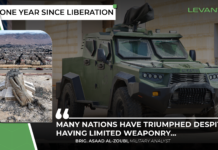
The remnants of Syria’s prolonged war continue to haunt its people, especially children, with tragic consequences. Explosive remnants of war (ERWs), including landmines and unexploded ordnance (UXO), are causing injuries and deaths across northwestern Syria. These remnants, left behind by the Assad regime and its allies, pose an enduring and indiscriminate threat to civilians, particularly in residential areas and agricultural lands.
On November 15, three siblings in the town of Azmarin, west of Idlib, were severely injured when a projectile from war remnants exploded while they were playing in their home, a refuge after displacement. One of the children, 10-year-old Anwar, lost his hand in the explosion, forever altering his life.
Rasha, Anwar’s sister, had been eagerly anticipating returning to school but now lies injured alongside her brothers. Yahya Al-Alloush, a volunteer paramedic with the Syrian Civil Defense, described the harrowing scene:
“Their faces were stained with blood, their bodies covered with shrapnel, and their eyes full of fear. The sound of the explosion was heavy and painful, and their injuries are a tragic reminder of how war’s remnants continue to destroy lives.”
The dangers of ERWs extend far beyond isolated incidents. On November 23, a 13-year-old boy was killed, and his 15-year-old brother was injured when a landmine exploded while they were picking olives near Maarbalit village in Idlib’s countryside. Similar tragedies unfold daily in Syria, where remnants of war are a persistent hazard in fields, homes, and public spaces.
In July, six ERW explosions killed one person and injured ten others, including eight children and a woman. During the first half of 2024, five incidents in northwestern Syria claimed the lives of three civilians, including a child, and injured ten others, all children.
The scale of the threat is staggering. According to the Syrian Civil Defense, 531 areas in northwestern Syria are contaminated with munitions, 45 of which are located in agricultural lands. In October alone, munitions survey teams conducted 119 surveys across 109 villages, identifying 71 contaminated areas.
ERWs frequently explode during routine activities, such as farming, grazing, or even within homes. On September 22, a man and his son were killed, and his wife and infant daughter injured, when a war remnant exploded in their home in Killi, north of Idlib. Earlier that month, a child tending sheep in Al-Ghab Plain was killed by a similar explosion.
Syria ranks among the deadliest countries for landmine and ERW victims. In 2023, the country recorded 933 deaths and injuries due to these hazards, second only to Myanmar, according to the International Campaign to Ban Landmines. For three consecutive years (2020–2022), Syria topped the global list for landmine victims, with thousands of casualties annually.
The Syrian Civil Defense is at the forefront of efforts to address the deadly legacy of war. Their teams have disposed of 1,054 pieces of unexploded ordnance and continue to conduct munitions surveys and awareness campaigns. However, the scale of contamination far outpaces available resources.
Al-Alloush emphasized the importance of continued efforts to protect civilians; “The regime and its allies have planted a long-term, timed death everywhere, in agricultural lands and between houses. Protecting lives from these remnants is a responsibility we must all share to prevent future disasters.”
For children like Rasha, Anwar, and Hussein, the consequences of war remnants are devastating and permanent. What should have been a day of joy and play turned into a nightmare. Their injuries and trauma are stark reminders of the toll that ERWs take on Syria’s most vulnerable. As the conflict drags on, these hidden killers remain a significant challenge for Syria’s recovery, threatening lives, livelihoods, and the futures of countless children.








